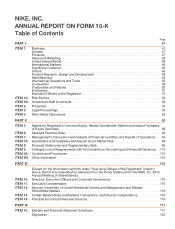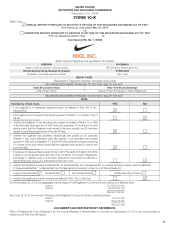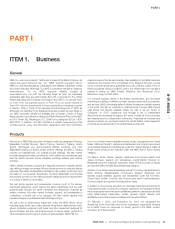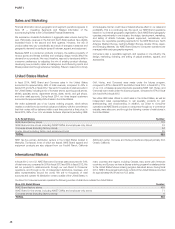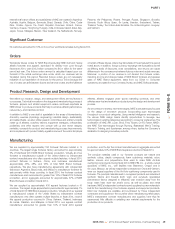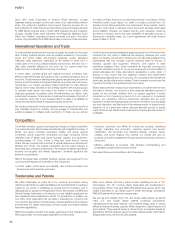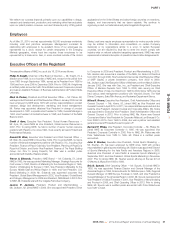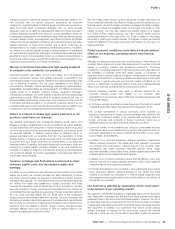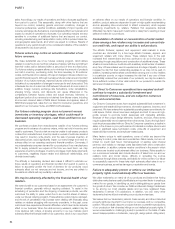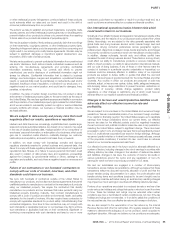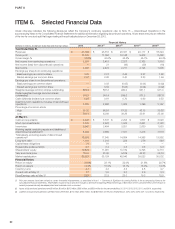Nike 2014 Annual Report Download - page 9
Download and view the complete annual report
Please find page 9 of the 2014 Nike annual report below. You can navigate through the pages in the report by either clicking on the pages listed below, or by using the keyword search tool below to find specific information within the annual report.PART I
ITEM 1A. Risk Factors
Special Note Regarding Forward-Looking Statements and
Analyst Reports
Certain written and oral statements, other than purely historic information,
including estimates, projections, statements relating to NIKE’s business
plans, objectives, and expected operating results, and the assumptions upon
which those statements are based, made or incorporated by reference from
time to time by NIKE or its representatives in this report, other reports, filings
with the SEC, press releases, conferences, or otherwise, are “forward-looking
statements” within the meaning of the Private Securities Litigation Reform Act
of 1995 and Section 21E of the Securities Exchange Act of 1934, as
amended. Forward-looking statements include, without limitation, any
statement that may predict, forecast, indicate, or imply future results,
performance, or achievements, and may contain the words “believe,”
“anticipate,” “expect,” “estimate,” “project,” “will be,” “will continue,” “will likely
result,” or words or phrases of similar meaning. Forward-looking statements
involve risks and uncertainties which may cause actual results to differ
materially from the forward-looking statements. The risks and uncertainties
are detailed from time to time in reports filed by NIKE with the SEC, including
Forms 8-K, 10-Q, and 10-K, and include, among others, the following:
international, national, and local general economic and market conditions; the
size and growth of the overall athletic footwear, apparel, and equipment
markets; intense competition among designers, marketers, distributors, and
sellers of athletic footwear, apparel, and equipment for consumers and
endorsers; demographic changes; changes in consumer preferences;
popularity of particular designs, categories of products, and sports; seasonal
and geographic demand for NIKE products; difficulties in anticipating or
forecasting changes in consumer preferences, consumer demand for NIKE
products, and the various market factors described above; difficulties in
implementing, operating, and maintaining NIKE’s increasingly complex
information systems and controls, including, without limitation, the systems
related to demand and supply planning and inventory control; interruptions in
data and information technology systems; consumer data security;
fluctuations and difficulty in forecasting operating results, including, without
limitation, the fact that advance futures orders may not be indicative of future
revenues due to changes in shipment timing, the changing mix of futures and
at-once orders, and discounts, order cancellations, and returns; the ability of
NIKE to sustain, manage, or forecast its growth and inventories; the size,
timing, and mix of purchases of NIKE’s products; increases in the cost of
materials, labor, and energy used to manufacture products, new product
development, and introduction; the ability to secure and protect trademarks,
patents, and other intellectual property; product performance and quality;
customer service; adverse publicity; the loss of significant customers or
suppliers; dependence on distributors and licensees; business disruptions;
increased costs of freight and transportation to meet delivery deadlines;
increases in borrowing costs due to any decline in NIKE’s debt ratings;
changes in business strategy or development plans; general risks associated
with doing business outside the United States, including, without limitation,
exchange rate fluctuations, import duties, tariffs, quotas, political and
economic instability, and terrorism; changes in government regulations; the
impact of, including business and legal developments relating to, climate
change; natural disasters; liability and other claims asserted against NIKE; the
ability to attract and retain qualified personnel; the effects of NIKE’s decision
to invest in or divest of businesses; and other factors referenced or
incorporated by reference in this report and other reports.
The risks included here are not exhaustive. Other sections of this report may
include additional factors which could adversely affect NIKE’s business and
financial performance. Moreover, NIKE operates in a very competitive and
rapidly changing environment. New risk factors emerge from time to time and
it is not possible for management to predict all such risk factors, nor can it
assess the impact of all such risk factors on NIKE’s business or the extent to
which any factor, or combination of factors, may cause actual results to differ
materially from those contained in any forward-looking statements. Given
these risks and uncertainties, investors should not place undue reliance on
forward-looking statements as a prediction of actual results.
Investors should also be aware that while NIKE does, from time to time,
communicate with securities analysts, it is against NIKE’s policy to disclose to
them any material non-public information or other confidential commercial
information. Accordingly, shareholders should not assume that NIKE agrees
with any statement or report issued by any analyst irrespective of the content
of the statement or report. Furthermore, NIKE has a policy against issuing or
confirming financial forecasts or projections issued by others. Thus, to the
extent that reports issued by securities analysts contain any projections,
forecasts, or opinions, such reports are not the responsibility of NIKE.
Our products face intense competition.
NIKE is a consumer products company and the relative popularity of various
sports and fitness activities and changing design trends affect the demand for
our products. The athletic footwear, apparel, and equipment industry is highly
competitive in the United States and on a worldwide basis. We compete
internationally with a significant number of athletic and leisure footwear
companies, athletic and leisure apparel companies, sports equipment
companies, and large companies having diversified lines of athletic and leisure
footwear, apparel, and equipment. We also compete with other companies
for the production capacity of independent manufacturers that produce our
products.
Product offerings, technologies, marketing expenditures (including
expenditures for advertising and endorsements), pricing, costs of production,
and customer service are areas of intense competition. This, in addition to
rapid changes in technology and consumer preferences in the markets for
athletic and leisure footwear and apparel, and athletic equipment, constitute
significant risk factors in our operations. If we do not adequately and timely
anticipate and respond to our competitors, our costs may increase or the
consumer demand for our products may decline significantly.
Failure to maintain our reputation and brand image could
negatively impact our business.
Our iconic brands have worldwide recognition, and our success depends on
our ability to maintain and enhance our brand image and reputation.
Maintaining, promoting, and growing our brands will depend on our design
and marketing efforts, including advertising and consumer campaigns,
product innovation, and product quality. Our commitment to product
innovation and quality and our continuing investment in design (including
materials) and marketing may not have the desired impact on our brand
image and reputation. We could be adversely impacted if we fail to achieve
any of these objectives or if the reputation or image of any of our brands is
tarnished or receives negative publicity. In addition, adverse publicity about
regulatory or legal action against us could damage our reputation and brand
image, undermine consumer confidence in us and reduce long-term demand
for our products, even if the regulatory or legal action is unfounded or not
material to our operations.
In addition, our success in maintaining, extending, and expanding our brand
image depends on our ability to adapt to a rapidly changing media
environment, including our increasing reliance on social media and online
dissemination of advertising campaigns. Negative posts or comments about
us on social networking websites could seriously damage our reputation and
brand image. If we do not maintain, extend, and expand our brand image,
then our product sales, financial condition, and results of operations could be
materially and adversely affected.
If we are unable to anticipate consumer preferences and
develop new products, we may not be able to maintain or
increase our revenues and profits.
Our success depends on our ability to identify, originate, and define product
trends as well as to anticipate, gauge, and react to changing consumer
demands in a timely manner. However, lead times for many of our products
may make it more difficult for us to respond rapidly to new or changing
product trends or consumer preferences. All of our products are subject to
52


